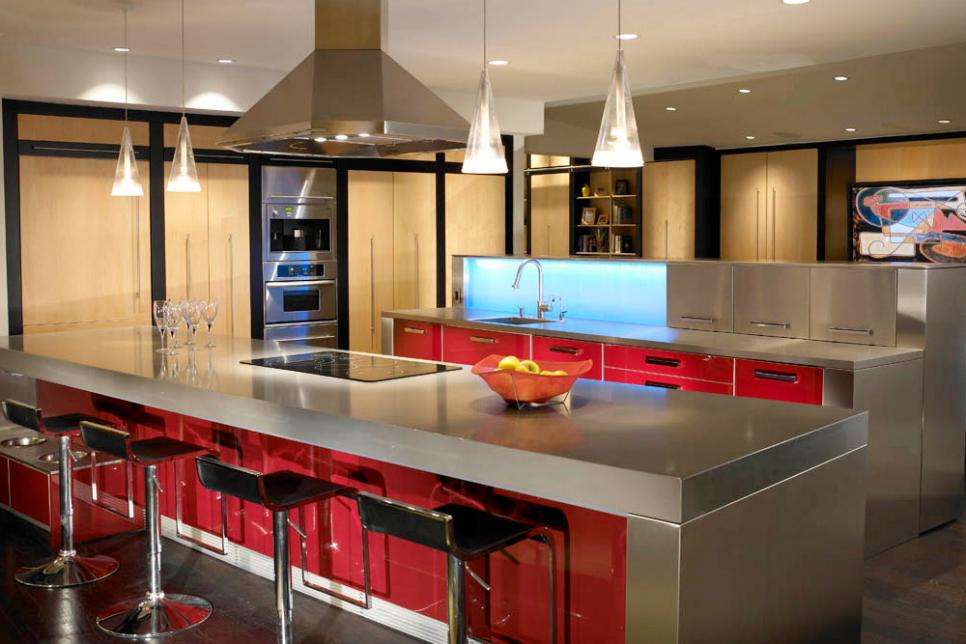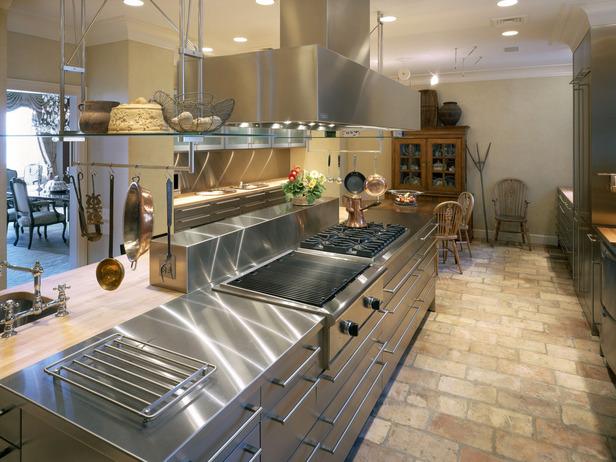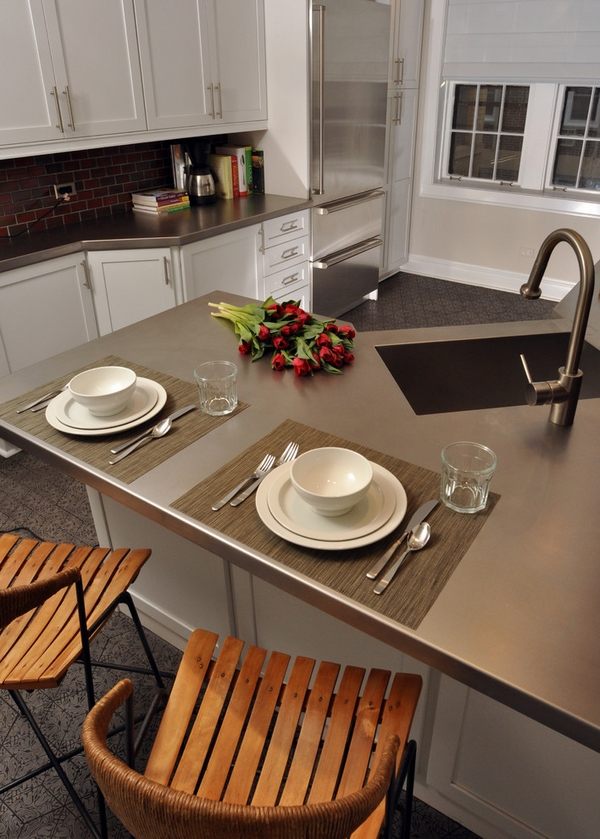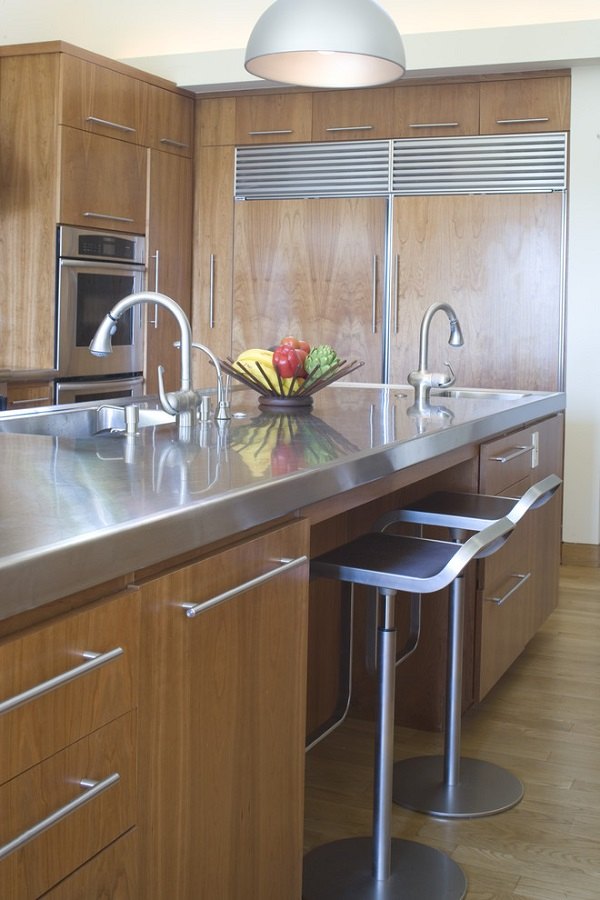Stainless steel kitchen countertops have long been a staple in professional kitchens, but they’ve increasingly made their way into home kitchens, where they offer both aesthetic appeal and practical advantages. One of the key reasons I’ve seen homeowners choose stainless steel countertops is their unmatched durability. Unlike other materials, stainless steel is resistant to heat, stains, and water damage, making it an ideal surface for a busy kitchen. You can place hot pots and pans directly on the surface without worrying about scorch marks, and spills are easy to wipe up without leaving a trace. This resilience makes stainless steel countertops a long-lasting investment, even in the most demanding kitchen environments.
Another significant advantage of stainless steel countertops is their hygiene. The non-porous surface of stainless steel doesn’t harbor bacteria, making it one of the most sanitary options available. I’ve always appreciated how easy it is to clean and maintain a stainless steel countertop. A simple wipe-down with a damp cloth and some mild soap is usually all it takes to keep the surface looking pristine. This ease of maintenance is especially appealing for those who love to cook or entertain, as it means less time spent cleaning up and more time enjoying the kitchen.

The sleek, modern look of stainless steel countertops is another reason they’ve become so popular. Their reflective surface can make a kitchen feel brighter and more spacious, which is a significant advantage in smaller or darker spaces. I’ve noticed that stainless steel countertops blend well with a variety of kitchen styles, from ultra-modern to industrial to transitional designs. They pair beautifully with other materials, such as wood, stone, or glass, creating a balanced and sophisticated look. The versatility of stainless steel allows homeowners to achieve a high-end, professional appearance without compromising on practicality.
One of the unique aspects of stainless steel countertops is the ability to customize them to suit your specific needs. Because stainless steel is often fabricated to order, you can have the countertop tailored to fit your kitchen’s dimensions, including integrated sinks, backsplashes, or even drainboards. I’ve found that this level of customization allows for a seamless, cohesive look in the kitchen, where every element is designed to work together. Whether you prefer a smooth, minimalist surface or one with more functional features, stainless steel can be adapted to your personal preferences.

In terms of environmental impact, stainless steel is a relatively sustainable option. It’s made from a significant percentage of recycled materials, and it’s fully recyclable at the end of its life. I appreciate that choosing stainless steel countertops aligns with eco-friendly principles, especially for those who are conscious of their environmental footprint. Additionally, the durability and longevity of stainless steel mean that you’re less likely to need to replace the countertop in the future, reducing waste and the need for new materials.
While stainless steel countertops have many advantages, it’s essential to consider the potential downsides as well. One of the most common concerns I’ve encountered is that stainless steel can be prone to scratches and dents. While the material is incredibly tough, it’s not entirely scratch-proof, and over time, you may notice small marks from knives, pots, or other kitchen tools. However, I’ve found that these scratches can add to the patina and character of the surface, giving it a more lived-in, industrial look. For those who prefer a pristine appearance, using cutting boards and taking care to avoid heavy impacts can help maintain the countertop’s condition.

Another aspect to consider is the potential for fingerprints and smudges on the surface. Stainless steel is known for showing fingerprints, which can be frustrating for some homeowners. However, I’ve found that regular cleaning with a microfiber cloth and a stainless steel cleaner can keep the surface looking clean and shiny. Some finishes are also more resistant to smudges than others, so it’s worth exploring your options if this is a concern. In any case, the trade-off for a few extra minutes of cleaning is a countertop that’s incredibly durable and easy to maintain in the long run.
The cost of stainless steel countertops can vary depending on the thickness of the material, the complexity of the design, and the level of customization required. Generally, stainless steel is on the higher end of the price spectrum compared to materials like laminate or tile. However, I believe the long-term benefits, such as durability, ease of maintenance, and timeless appeal, make stainless steel a worthwhile investment. It’s also important to consider the installation costs, as professional fabrication and installation are usually necessary to achieve a seamless look.
One of the features I love about stainless steel countertops is their ability to complement other kitchen elements, such as appliances and fixtures. In a kitchen with stainless steel appliances, the countertop can tie the entire look together, creating a cohesive and polished appearance. Additionally, stainless steel pairs well with a variety of cabinet colors and styles, from sleek white or black cabinets to warm wood tones. This adaptability means that even if you decide to update other aspects of your kitchen in the future, your stainless steel countertop will continue to look great.
For those who enjoy baking or working with dough, stainless steel countertops offer a smooth, cool surface that’s perfect for rolling out pastries or kneading bread. I’ve heard from many home bakers that the coolness of stainless steel is ideal for working with delicate doughs, as it helps prevent sticking and keeps ingredients at the right temperature. This functional aspect adds another layer of utility to stainless steel countertops, making them a favorite among both professional chefs and home cooks alike.

In terms of design flexibility, stainless steel countertops can be integrated into various kitchen layouts, from large islands to smaller galley kitchens. Because they are custom-made, they can be designed to fit around existing features, such as sinks, cooktops, or even architectural details. I’ve seen how a well-designed stainless steel countertop can enhance the flow of a kitchen, providing ample workspace while also serving as a striking design element. Whether your kitchen is large or small, modern or traditional, stainless steel can be tailored to meet your specific needs.
Another consideration with stainless steel countertops is noise. The material can be louder than others, especially when placing pots, pans, or utensils on the surface. While this might be a drawback for some, I’ve found that adding plywood backing during installation can help dampen the sound, making the countertop quieter and more comfortable to use. Additionally, using silicone mats or trivets can reduce noise and protect the surface from scratches and heat.
Stainless steel countertops are also highly resistant to corrosion and rust, which is particularly important in a kitchen environment where water and moisture are constantly present. I’ve always been impressed by how well stainless steel holds up over time, even in high-moisture areas like around sinks or near dishwashers. This corrosion resistance ensures that your countertop will maintain its appearance and functionality for years, even with daily use.
Finally, stainless steel countertops offer a timeless appeal that can enhance the value of your home. While trends in kitchen design come and go, stainless steel has remained a popular choice for decades due to its combination of beauty and practicality. I believe that investing in a stainless steel countertop is not only a decision that will serve you well in your day-to-day life but also one that can boost the overall appeal and value of your home, making it an excellent choice for both current enjoyment and future resale.

Common Mistakes to Avoid
One common mistake I’ve seen people make with stainless steel countertops is not accounting for the potential for scratches and dents. While the material is incredibly durable, it’s not impervious to damage, so it’s important to use cutting boards and avoid dropping heavy items on the surface.
Another mistake is choosing the wrong finish. Some finishes are more prone to showing fingerprints and smudges, so it’s crucial to select one that fits your lifestyle and cleaning preferences. Additionally, improper installation can lead to a noisy countertop or one that doesn’t fit perfectly with your kitchen layout, so professional installation is highly recommended.
Lastly, neglecting to clean and maintain the surface regularly can result in a dull, lifeless appearance, so it’s essential to follow the manufacturer’s care instructions to keep your countertop looking its best.

What are the main benefits of stainless steel kitchen countertops?
Stainless steel kitchen countertops offer numerous benefits, including durability, hygiene, and a sleek, modern appearance. They are resistant to heat, stains, and water damage, making them ideal for busy kitchens. The non-porous surface doesn’t harbor bacteria, making stainless steel one of the most sanitary options available. Additionally, stainless steel countertops are easy to clean and maintain, and they can be customized to fit your kitchen’s specific needs, including integrated sinks and backsplashes.
How do I maintain and clean stainless steel countertops?
Maintaining stainless steel countertops is relatively simple. Regular cleaning with a damp cloth and mild soap is usually all that’s needed to keep the surface looking pristine. For stubborn spots or fingerprints, a stainless steel cleaner or a mixture of water and vinegar can be used. It’s important to avoid using abrasive cleaners or scrubbing pads, as these can scratch the surface. To maintain the countertop’s shine, you can also use a microfiber cloth to buff the surface after cleaning.
Are stainless steel countertops prone to scratches and dents?
Yes, stainless steel countertops can be prone to scratches and dents, especially if heavy items are dropped on them or if knives are used directly on the surface. However, many people find that the small scratches that develop over time add to the patina and character of the countertop. To minimize the risk of damage, it’s recommended to use cutting boards and avoid dragging heavy objects across the surface. Some finishes are more resistant to scratches than others, so it’s worth considering your options when choosing a stainless steel countertop.

Can stainless steel countertops be customized?
Stainless steel countertops are highly customizable. Because they are often fabricated to order, you can have the countertop tailored to fit your kitchen’s exact dimensions and layout. This customization can include integrated sinks, backsplashes, drainboards, and even specific edge profiles. The ability to customize makes stainless steel an excellent choice for those who want a seamless, cohesive look in their kitchen. It’s also possible to choose from different finishes, thicknesses, and other design elements to create a countertop that perfectly suits your style and needs.
What is the cost of stainless steel kitchen countertops?
The cost of stainless steel kitchen countertops can vary widely depending on factors such as the thickness of the material, the level of customization, and the complexity of the installation. Generally, stainless steel is on the higher end of the price spectrum compared to materials like laminate or tile. However, the long-term benefits, such as durability, ease of maintenance, and timeless appeal, make stainless steel a worthwhile investment. Professional installation is usually required, which can add to the overall cost, but ensures a seamless and professional result.
Are stainless steel countertops environmentally friendly?
Stainless steel is considered a relatively sustainable option for kitchen countertops. It is made from a significant percentage of recycled materials, and it is fully recyclable at the end of its life. Additionally, the durability and longevity of stainless steel mean that you’re less likely to need to replace the countertop in the future, reducing waste and the need for new materials. For those who are conscious of their environmental footprint, choosing stainless steel countertops aligns with eco-friendly principles and contributes to a more sustainable kitchen design.

Related Posts:
- Decorating Kitchen Countertops
- Kitchen Countertop Compost Pail
- Kitchen Countertops Ct
- Kitchen Countertop Resurfacing Ideas
- Kitchen Countertops Tampa Fl
- Kitchen Countertop Remnants
- Best Countertop Material For Outdoor Kitchen
- Green Granite Countertops Kitchen
- Quartz Countertops For Outdoor Kitchens
- Can I Paint Kitchen Countertops